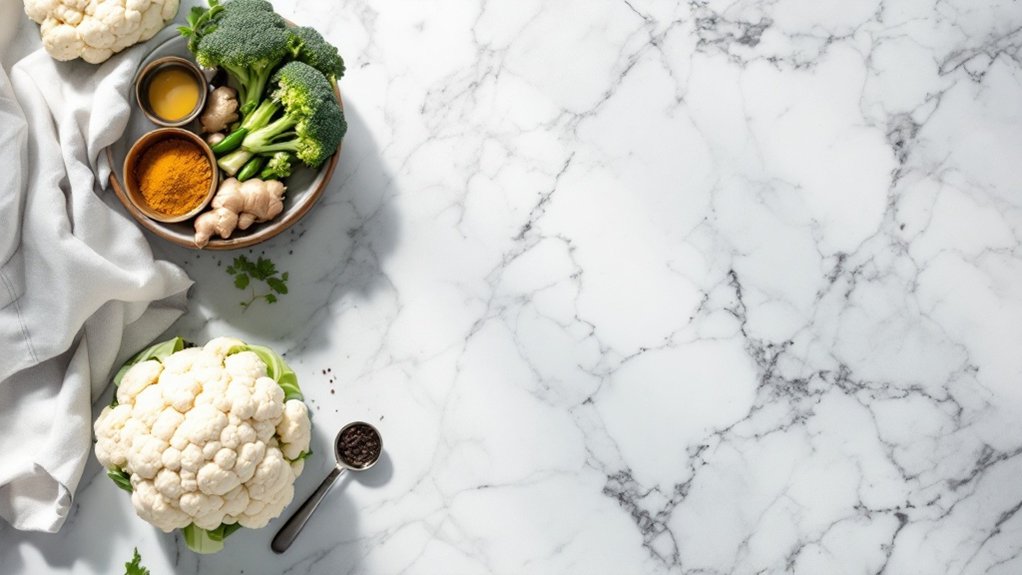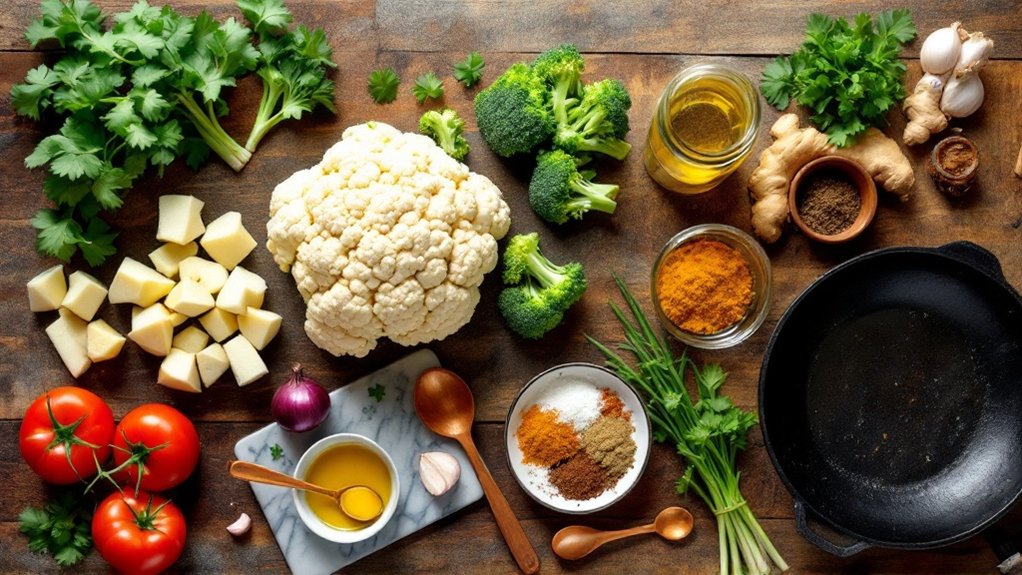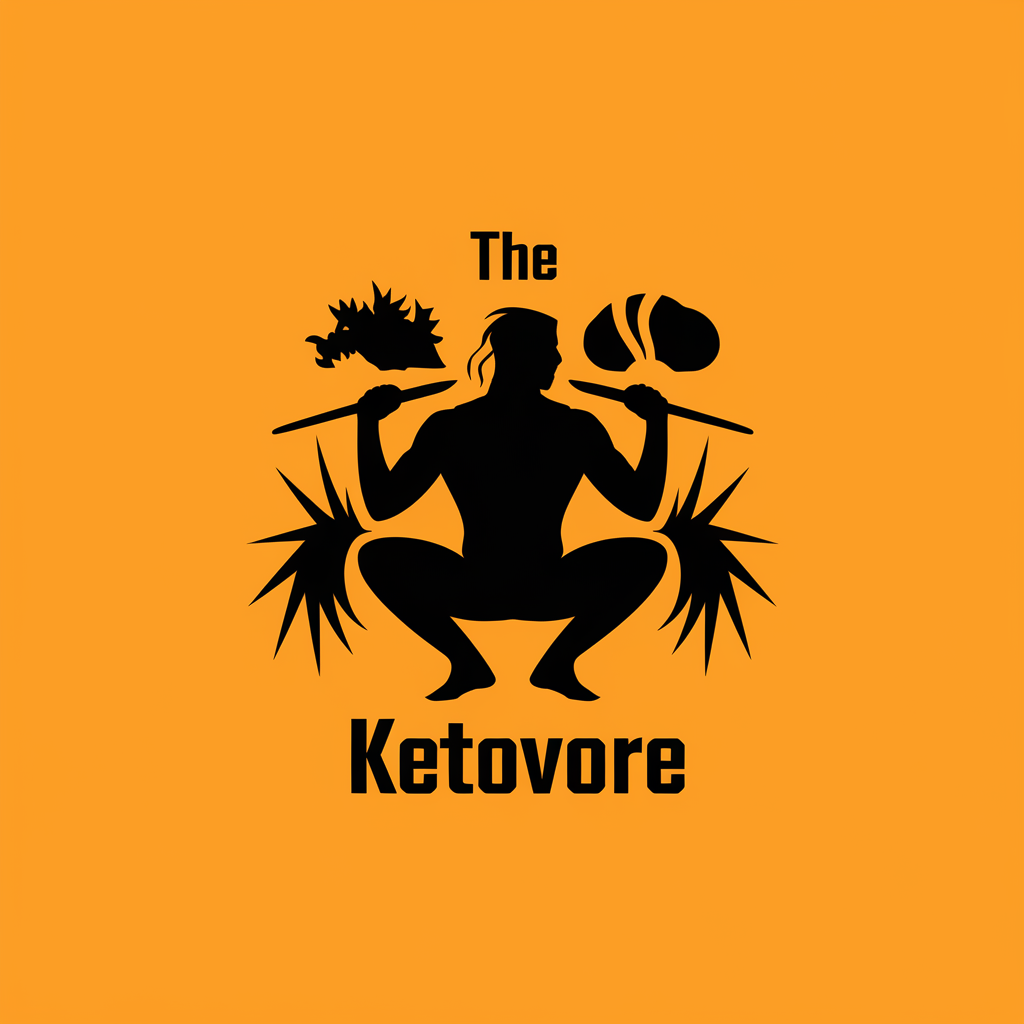
You’ve probably never considered that India’s beloved aloo gobi, traditionally made with potatoes and cauliflower, traces its roots to ancient Persian cuisine. Now you’ll find this dish shape-shifting to meet modern dietary needs, with clever keto adaptations replacing those carb-heavy spuds with radishes or turnips (a swap that would make your grandmother’s eyes widen in disbelief). Let’s explore how this centuries-old comfort food has evolved into a low-carb revelation that’ll make your taste buds dance and your ketone levels sing.

Against the backdrop of Indian cuisine’s rich heritage, keto aloo gobi (literally “potato cauliflower”) might seem like a contradiction – after all, potatoes aren’t exactly low-carb friendly.
But you’ll find this vibrant reimagining is a feast for both your eyes and palate, featuring tender cauliflower florets nestled against emerald broccoli pieces (your low-carb potato stand-ins).
You’re looking at a symphony in green and ivory, where the vegetables glisten with aromatic spices and golden ghee.
The florets catch the light like tiny, edible sculptures, their surfaces crisped to perfection while maintaining that coveted tender-crisp interior.
Notice how the turmeric and cumin create a warm, earthy palette that’ll make your mouth water before you’ve even grabbed your fork.
History
While traditional aloo gobi has graced Indian tables for centuries, its keto transformation represents a fascinating culinary evolution that’s sweeping through modern kitchens.
You’ll find that this low-carb remix (where cauliflower plays both itself and the potato) emerged during the 2010s alongside the ketogenic diet‘s surge in popularity.
As you explore this dish’s journey, you’ll notice how it brilliantly bridges two worlds: the time-honored Indian spice traditions and today’s carb-conscious creativity.
What started as a creative solution for potato-loving keto enthusiasts has blossomed into its own legitimate variation, proving that even centuries-old recipes can dance to modern dietary tunes.
The addition of broccoli (a non-traditional twist) further cements its status as a contemporary interpretation.
Recipe

Keto Aloo Gobi is a low-carb adaptation of the classic Indian cauliflower and potato dish. By replacing potatoes with radish or turnip, this version maintains the traditional flavors while keeping carbohydrates minimal. The dish combines aromatic Indian spices with tender vegetables to create a satisfying side dish or main course.
This recipe takes approximately 30 minutes to prepare and serves 4-6 people as a side dish. The key to achieving the perfect texture is to avoid overcooking the vegetables while ensuring they’re tender enough to absorb the spices. The result is a fragrant, golden-yellow dish that pairs well with keto naan or cauliflower rice.
- 1 large cauliflower head, cut into florets
- 2 medium daikon radishes or turnips, diced
- 3 tablespoons ghee or coconut oil
- 1 teaspoon cumin seeds
- 1 medium onion, finely chopped
- 2 garlic cloves, minced
- 1-inch ginger piece, grated
- 2 medium tomatoes, chopped
- 1 teaspoon turmeric powder
- 1 teaspoon ground cumin
- 1 teaspoon ground coriander
- 1 teaspoon garam masala
- Salt to taste
- Fresh cilantro for garnish
Heat ghee in a large pan over medium heat and add cumin seeds until they start to sizzle. Add onions and cook until translucent, then add garlic and ginger. Stir in tomatoes and all dry spices, cooking for 2-3 minutes.
Add radishes and cauliflower, cover the pan, and cook on medium-low heat for 15-20 minutes, stirring occasionally until vegetables are tender but not mushy. Garnish with fresh cilantro before serving.
For extra flavor, try roasting the cauliflower for 10 minutes before adding it to the pan. To make the dish milder, reduce the amount of garam masala or substitute with mild curry powder.
For a different twist, kohlrabi can be used instead of radish or turnip. To increase the fat content for strict keto diets, drizzle with extra ghee or coconut oil before serving.
Final Thoughts
Creating this vibrant, spice-laden dish brings the essence of traditional Indian cuisine straight to your keto kitchen, where every aromatic bite transports you to bustling markets and cozy family dinners.
You’ll find that this clever twist on aloo gobi (minus the actual aloo) scratches that comfort-food itch without derailing your low-carb goals.
Let’s be honest – while cauliflower’s been masquerading as everything from rice to pizza crust lately, here it finally gets to shine as its authentic self, dancing with its cruciferous cousin broccoli in a warmly spiced embrace.
The result? A dish that’s not just keto-compliant but genuinely crave-worthy, proving that sometimes the best culinary innovations come from embracing limitations rather than fighting them.


